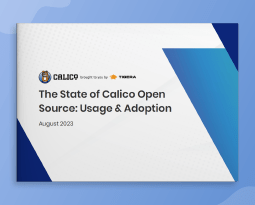On the ‘net: Model Based Thinking
Running a little late on cross posting stuff from Packet Pushers … but I suppose better late than never. 
Running a little late on cross posting stuff from Packet Pushers … but I suppose better late than never. 
Welcome to the Calico monthly roundup: October edition! From open source news to live events, we have exciting updates to share—let’s get into it!
Join us at KubeCon + CloudNativeCon North America 2023
We’re gearing up for KubeCon + CloudNativeCon 2023 in Chicago. Join us at booth #G13 for exciting Kubernetes security updates and pick up some cool new Calico swag! |
Customer case study: eHealth
Calico provides visibility and zero-trust security controls for eHealth on Amazon EKS. Read our new case study to find out how. |
|
Learn why a traditional firewall architecture doesn’t work for modern cloud-native applications and results in a huge resource drain in a production environment. |

The State of Calico Open Source: Usage & Adoption Report 2023 Get insights into Calico’s adoption across container and Kubernetes environments, in terms of platforms, data planes, and policies. |
The Future of Networking series continues with Brad Casemore, who survived multiple decades in the technology sector, including sixteen years as an analyst for IDC. He's been a longtime observer of networking markets, technologies, and trends. We talk about the interest in AI and try to separate the hype from the reality, multi-cloud networking, and more.
The post HN708: The Future Of Networking With Brad Casemore – Part 1 appeared first on Packet Pushers.
At least some people learn from others’ mistakes: using the concepts proven by some well-publicized BGP leaks, malicious actors quickly figured out how to hijack BGP prefixes for fun and profit.
Fortunately, those shenanigans wouldn’t spread as far today as they did in the past – according to RoVista, most of the largest networks block the prefixes Route Origin Validation (ROV) marks as invalid.
Notes:
At least some people learn from others’ mistakes: using the concepts proven by some well-publicized BGP leaks, malicious actors quickly figured out how to hijack BGP prefixes for fun and profit.
Fortunately, those shenanigans wouldn’t spread as far today as they did in the past – according to RoVista, most of the largest networks block the prefixes Route Origin Validation (ROV) marks as invalid.
Notes:
Grab a rundown of what to expect at KubeCon NA this year as Kubernetes Unpacked co-host Michael Levan prepares to hit the conference floor.
The post KU039: Prepping For KubeCon North America 2023 appeared first on Packet Pushers.
It’s time to gather round the hedge and discuss whatever Eyvonne, Tom, and Russ find interesting! In this episode we discuss business logic vulnerabilities, and how we often forget to think outside the box to understand the attack surfaces that matter. We also discuss upcoming network speed increases like Wi-Fi 7 and 800G Ethernet. Do we really need these speeds, or are we just getting caught up in a hype cycle?